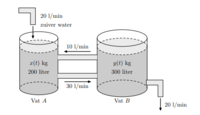Hi it is almost time for my exams, and to prepare us our professor gave us some questions he asked the previous years. I have solved almost all of them but the final one has me completely baffled. the question goes as follows:
Barrel A is filled with 200 L of salt solution. We call x(t) the amount of kg salt in barrel A (t in minuts). Barrel B is filled with 300 L salt solution and y(t) is the amount of kg of salt in barrel B. Each minute 10L flows from B to A and 30L flows from A to B. on top of that there is a tap above barrel A which adds 20l/min to barrel a and a drain underneath barrel B which removes 20l/min. Because of this the overall volume level remains the same.
a) proof that x(t) and y(t) follow the following Differential equations: - x'(t) = (-3/20)x(t) + (1/30)y(t)
- y'(t) = (3/20)x(t) - (1/10)y(t)
b) get y from the fist equation en substitute in the second equation to form a second order diff. equation in x and solve (still constants in answer)
c) If you know that there was 20kg of salt in barrel A at time 0 and 15kg in barrel b what are the formulas for x(t) and y(t) (remove the constants).
In general I find stuff to "proof that x = y" to be very difficult as I never quite know where to start. If anybody could help me out with some sort of general strategy that would be most apreciated.
there is a image of the set-up added.
-kind regards
Maxim

Barrel A is filled with 200 L of salt solution. We call x(t) the amount of kg salt in barrel A (t in minuts). Barrel B is filled with 300 L salt solution and y(t) is the amount of kg of salt in barrel B. Each minute 10L flows from B to A and 30L flows from A to B. on top of that there is a tap above barrel A which adds 20l/min to barrel a and a drain underneath barrel B which removes 20l/min. Because of this the overall volume level remains the same.
a) proof that x(t) and y(t) follow the following Differential equations: - x'(t) = (-3/20)x(t) + (1/30)y(t)
- y'(t) = (3/20)x(t) - (1/10)y(t)
b) get y from the fist equation en substitute in the second equation to form a second order diff. equation in x and solve (still constants in answer)
c) If you know that there was 20kg of salt in barrel A at time 0 and 15kg in barrel b what are the formulas for x(t) and y(t) (remove the constants).
In general I find stuff to "proof that x = y" to be very difficult as I never quite know where to start. If anybody could help me out with some sort of general strategy that would be most apreciated.
there is a image of the set-up added.
-kind regards
Maxim

